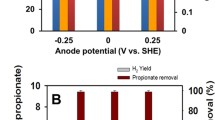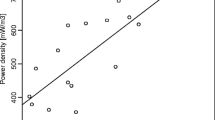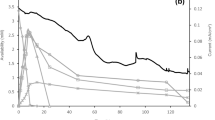Abstract
We determined the kinetic response of a community of anode-respiring bacteria oxidizing a mixture of the most common fermentation products: acetate, butyrate, propionate, ethanol, and hydrogen. We acclimated the community by performing three consecutive batch experiments in a microbial electrolytic cell (MEC) containing a mixture of the fermentation products. During the consecutive-batch experiments, the coulombic efficiency and start-up period improved with each step. We used the acclimated biofilm to start continuous experiments in an MEC, in which we controlled the anode potential using a potentiostat. During the continuous experiments, we tested each individual substrate at a range of anode potentials and substrate concentrations. Our results show low current densities for butyrate and hydrogen, but high current densities for propionate, acetate, and ethanol (maximum values are 1.6, 9.0, and 8.2 A/m2, respectively). Acetate showed a high coulombic efficiency (86%) compared to ethanol and propionate (49 and 41%, respectively). High methane concentrations inside the MEC during ethanol experiments suggest that methanogenesis is one reason why the coulombic efficiency was lower than that of acetate. Our results provide kinetic parameters, such as the anode overpotential, the maximum current density, and the Monod half-saturation constant, that are needed for model development when using a mixture of fermentation products. When we provided no electron donor, we measured current due to endogenous decay of biomass (~0.07 A/m2) and an open-cell potential (−0.54 V vs Ag/AgCl) associated with biomass components active in endogenous respiration.





Similar content being viewed by others
References
Bard AJ, Faulkner LR (2001) Electrochemical methods. Wiley, New York
Bond DR, Lovley DR (2003) Electricity production by Geobacter sulfurreducens attached to electrodes. Appl Environ Microb 69:1548–1555
Chaudhuri SK, Lovley DR (2003) Electricity generation by direct oxidation of glucose in mediatorless microbial fuel cells. Nat Biotechnol 21:1229–1232
Dentel SK, Strogen B, Chiu P (2004) Direct generation of electricity from sludges and other liquid wastes. Water Sci Technol 50:161–168
Droste RL (1998) Endogenous decay and bioenergetics theory for aerobic wastewater treatment. Water Res 32:410–418
Grosz R, Stephanopoulos G (1983) Statistical mechanical estimation of the free-energy of formation of E. coli biomass for use with macroscopic reactor balances. Biotechnol Bioeng 25:2149–2163
Heijnen JJ, van Loosdrecht MCM, Tijhuis L (1992) A black box mathematical model to calculate auto- and heterotrophic biomass yields based on Gibbs energy dissipation. Biotechnol Bioeng 40:1139–1154
Hwang MH, Jang NJ, Hyun SH, Kim IS (2004) Anaerobic bio-hydrogen production from ethanol fermentation: the role of pH. J Biotechnol 111:297–309
Kato Marcus A, Torres CI, Rittmann BE (2007) Conduction based modeling of the biofilm anode of a microbial fuel cell. Biotechnol Bioeng (in press). DOI https://doi.org/10.1002/bit.21533
Kim JR, Jung SH, Regan JM, Logan BE (2007) Electricity generation and microbial community analysis of alcohol powered microbial fuel cells. Bioresour Technol 98:2568–2577
Kus F, Wiesmann U (1995) Degradation kinetics of acetate and propionate by immobilized anaerobic mixed cultures. Water Res 29:1437–1443
Lee JY, Phung NT, Chang IS, Kim BH, Sung HC (2003) Use of acetate for enrichment of electrochemically active microorganisms and their 16S rDNA analyses. FEMS Microbiol Lett 223:185–191
Liu H, Grot S, Logan BE (2005a) Electrochemically assisted microbial production of hydrogen from acetate. Environ Sci Technol 39:4317–4320
Liu H, Cheng SA, Logan BE (2005b) Production of electricity from acetate or butyrate using a single-chamber microbial fuel cell. Environ Sci Technol 39:658–662
Metje M, Frenzel P (2005) Effect of temperature on anaerobic ethanol oxidation and methanogenesis in acidic peat from a northern wetland. Appl Environ Microb 71:8191–8200
Min B, Logan BE (2004) Continuous electricity generation from domestic wastewater and organic substrates in a flat plate microbial fuel cell. Environ Sci Technol 38:5809–5814
Min B, Kim JR, Oh SE, Regan JM, Logan BE (2005) Electricity generation from swine wastewater using microbial fuel cells. Water Res 39:4961–4968
Oh SE, Logan BE (2005) Hydrogen and electricity production from a food processing wastewater using fermentation and microbial fuel cell technologies. Water Res 39:4673–4682
Picioreanu C, Heam IM, Katuri KP, van Loosdrecht MCM, Scott K (2007) A computational model for biofilm-based microbial fuel cells. Water Res 41:2921–2940
Rabaey K, Verstraete W (2005) Microbial fuel cells: novel biotechnology for energy generation. Trends Biotechnol 23:291–298
Rabaey K, Van de Sompel K, Maignien L, Boon N, Aelterman P, Clauwaert P, De Schamphelaire L, Pham HT, Vermeulen J, Verhaege M, Lens P, Verstraete W (2006) Microbial fuel cells for sulfide removal. Environ Sci Technol 40:5218–5224
Sáez PB, Rittmann BE (1992) Model-parameter estimation using least-squares. Water Res 26:789–796
Ren NQ, Wang BZ, Huang JC (1997) Ethanol-type fermentation from carbohydrate in high rate acidogenic reactor. Biotechnol and Bioeng 54:428–433
Rittmann BE, McCarty PL (2001) Environmental biotechnology: principles and applications. McGraw-Hill, New York, USA
Roels JA (1980) Application of macroscopic principles to microbial metabolism. Biotechnol Bioeng 22:2457–2514
VanBriesen JM (2002) Evaluation of methods to predict bacterial yield using thermodynamics. Biodegradation 13:171–190
Wang J (2000) Analytical Electrochemistry. Wiley, Chichester, England
Wu JH, Lin CY (2004) Biohydrogen production by mesophilic fermentation of food wastewater. Water Sci Technol 49:223–228
Ying Z, Yang ST (2004) Effect of pH on metabolic pathway shift in fermentation of xylose by Clostridium tyrobutyricum. J Biotechnol 110:143–157
Yu HQ, Fang HHP (2003) Acidogenesis of gelatin-rich wastewater in an upflow anaerobic reactor: influence of pH and temperature. Water Res 37:55–66
Zhang XC, Halme A (1995) Modeling of a microbial fuel-cell process. Biotechnol Lett 17:809–814
Acknowledgment
The funding for this work was provided by OpenCEL and NZ Legacy.
Author information
Authors and Affiliations
Corresponding author
Rights and permissions
About this article
Cite this article
Torres, C.I., Kato Marcus, A. & Rittmann, B.E. Kinetics of consumption of fermentation products by anode-respiring bacteria. Appl Microbiol Biotechnol 77, 689–697 (2007). https://doi.org/10.1007/s00253-007-1198-z
Received:
Revised:
Accepted:
Published:
Issue Date:
DOI: https://doi.org/10.1007/s00253-007-1198-z




